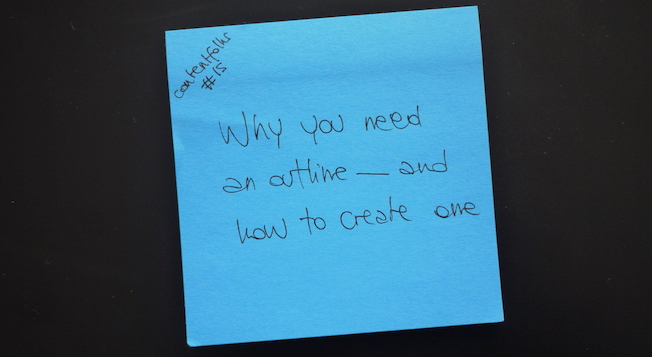
Welcome to contentfolks—a fortnightly newsletter with short lessons & ideas about content that makes a difference, sparks action, and truly serves its audience. Thank you for being here!
Hey 👋
Previously, on content folks: a published blog post is like the tip of an iceberg—under its visible part there’s an enormous amount of stuff that is hard to see and, therefore, easy to ignore.

…but I think it’s useful to document the full iceberg experience! So I’m using multiple issues of this contentfolks newsletter to take you behind the scenes of a blog post I’ve been working on.
Last time, we looked at the research process you need to build a content brief that covers a piece’s ideal audience, its main angle, and your goals for creating it. But while a brief tells you WHAT your piece will cover and WHY, it doesn’t tell you HOW—and that’s what the outline is for.
What an outline looks like
An outline is the foundation of a content piece, signposting how your argument will unfold. At its most basic it’s an ordered list of headings and sub-headings, while more in-depth outlines might include summaries and/or additional detail.

Regardless of its format, an outline is an unskippable part of content creation.***
It helps structure your thoughts and research, and plan out and sequence the information your piece will include.
***as a young marketer, I thought only the most uninspired and uncreative of writers needed outlines, while truly great creators (read: me) were able to free-write their way into excellence every time. Cue me wasting months feeling all Emo Romantic Writer, staring at blank pages or struggling to figure out where my meandering prose was going 🤦♀️ Don’t be like old me. Nowadays, I rarely do anything without an outline—even this newsletter started as a short list of things I wanted you to know.
💡 A practical example 💡
Back to the blog post I’ve been working on—a piece about content calendars for Ahrefs’ blog.
While researching the brief, I scribbled down notes in a Google doc. Here is the easy, 4-step process I followed:
- Read top-ranking articles about the topic to understand the most frequent points they make
- Review Google’s “People also ask” box to find the most commonly asked questions about it
- Watch YouTube videos to see how people think and talk about it
- Identify new angles and knowledge gaps your piece could fill
And here’s what some of my notes looked like:
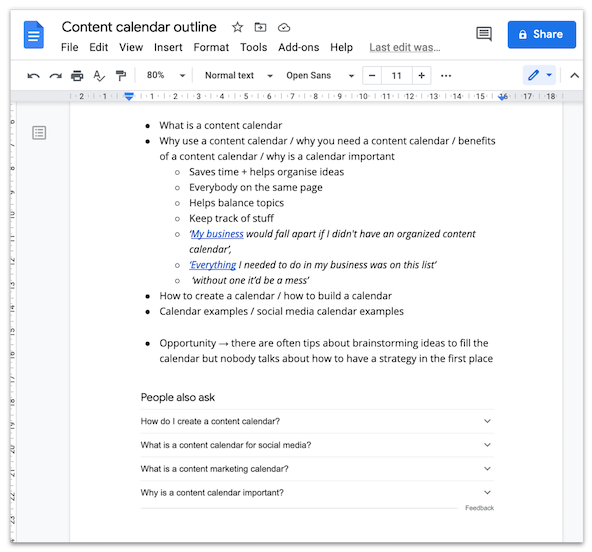
The next step in the process was organising all of this info into a logical structure, and that’s where outlining begins.
The most important information comes first
The structure of an outline depends on what you want your piece to accomplish. My article will educate readers about content calendars so I chose the ‘inverted pyramid’ method, starting from the most important information and adding progressively more detail as the piece unfolds.
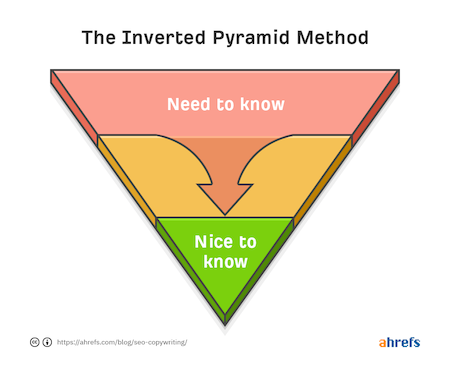
Accordingly, my outline starts like this:

Since I’ll be writing the piece, this is enough detail. When you’re outlining for someone else, you may need to flesh out the document a bit more—enough for the writer to know what you’re expecting, but leaving ample space for them to contribute ideas and expertise.
Find the best flow for your readers
Sometimes, even with the inverted pyramid method, it’s not immediately clear what comes next. Take a look at these two sections: which should come first?
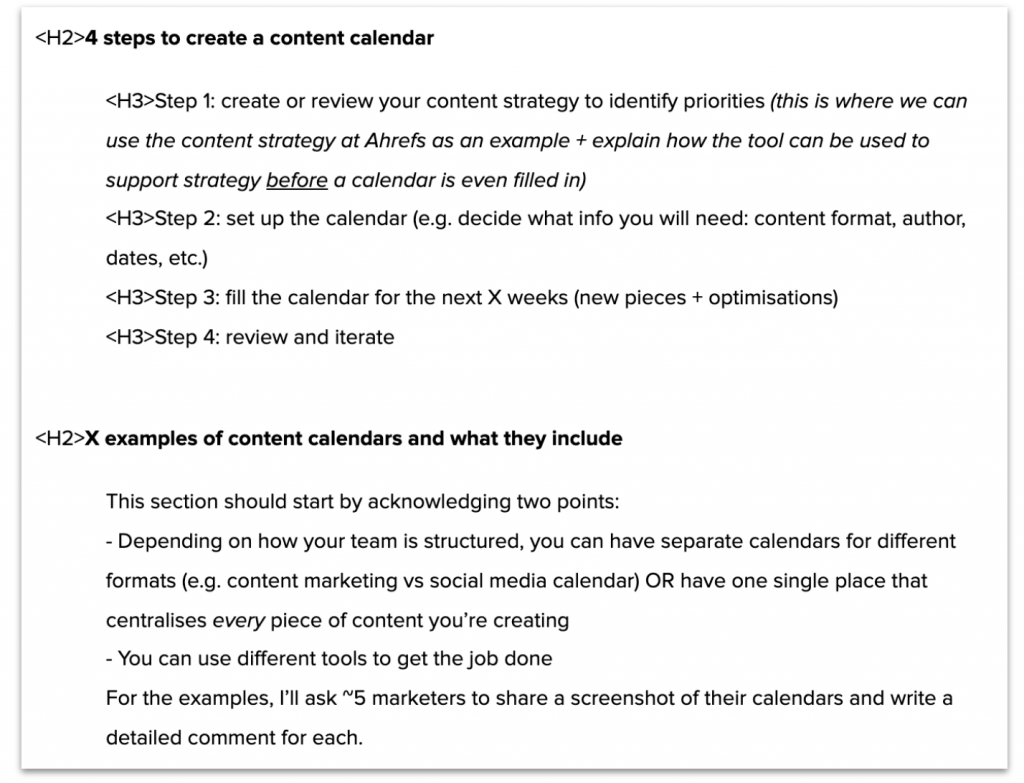
- I could go wide → narrow, starting with general examples to paint a picture in the reader’s mind before taking them through the concrete steps needed to create a calendar
- I could go narrow → wide, explaining how a calendar is built first so the reader has more context to understand the examples that follow
This is where you have to really put yourself in your audience’s shoes and think about what will help them the most and will be easier to digest.
Joshua at Ahrefs thought the first option might prove too overwhelming for somebody new to the topic, and I agreed—so I organised the flow accordingly. It always helps to get an editor’s take 😉
- I could go wide → narrow, starting with general examples to paint a picture in the reader’s mind before taking them through the concrete steps needed to create a calendar
- I could go narrow → wide, explaining how a calendar is built first so the reader has more context to understand the examples that follow
This is where you have to really put yourself in your audience’s shoes and think about what will help them the most and will be easier to digest.
Joshua at Ahrefs thought the first option might prove too overwhelming for somebody new to the topic, and I agreed—so I organised the flow accordingly. It always helps to get an editor’s take 😉
🔥 Pro tip: outlining is not just about figuring out the best way to cover a topic, it’s also about identifying where and how to weave a product, service, or company into the narrative.
In my case, most top-ranking articles about calendars don’t mention the importance of content strategy → this is a great opportunity for mine to do something different and tie the concept of calendar to that of strategy while using Ahrefs examples for both:
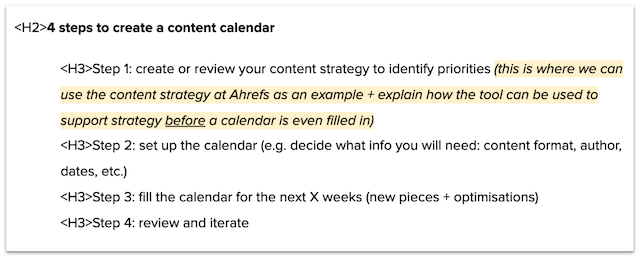
Think about what your audience really needs
Just because a piece is keyword-led, doesn’t mean it should only cover what Google or other SEO tools deem relevant. If you have useful information that will help your audience, add it in—keyword or no keyword.
For example: no data suggests that people searching for content calendars also want tips, but I bet someone new to the topic would appreciate them anyway. Therefore, I decided to wrap up my outline with a ‘final tips’ section:

🔥 Pro tip #1: it helps to have first-hand experience of a topic so you can contribute your own angle—but when you don’t and/or you’d like additional sounding boards, it’s useful to reach out to subject matter experts and see if there’s anything they can contribute, like I did here:

🔥 Pro tip #2: when you create briefs and outlines for someone else, it helps to talk through your choices before handing over. I usually record a 5-minute Loom video, share my screen, and give a quick summary of what I’m expecting—it’s helpful to hear someone explain what they have in mind… plus, it adds a nice human touch 🙂
With both brief and outline done, we have now successfully explored the first two parts of the iceberg ✅
Take a closer look at both in this shared doc. Don’t let their apparent simplicity deceive you: it took a lot of upfront research, thinking, and work to create them…
…but it’s not as hard a job as having to write the draft itself 😅
And for that, I’ll see you next time, on April 28.
Ciao for now,
